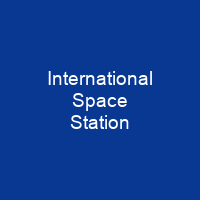International Space Station

The International Space Station is a modular space station in low Earth orbit. It is a multinational collaborative project involving five participating space agencies. The station serves as a microgravity and space environment research laboratory in which scientific research is conducted in astrobiology, astronomy, meteorology, physics, and other fields. The ISS is suited for testing the systems and equipment required for possible future long-duration missions to the Moon and Mars.
About International Space Station in brief
 The International Space Station is a modular space station in low Earth orbit. It is a multinational collaborative project involving five participating space agencies. The station serves as a microgravity and space environment research laboratory in which scientific research is conducted in astrobiology, astronomy, meteorology, physics, and other fields. The ISS is suited for testing the spacecraft systems and equipment required for possible future long-duration missions to the Moon and Mars. The first ISS component was launched in 1998, and the first long-term residents arrived on 2 November 2000. As of September 2019, 239 astronauts, cosmonauts, and space tourists from 19 different nations have visited the space station, many of them multiple times; this includes 151 Americans, 47 Russians, nine Japanese, eight Canadians, and five Italians. The latest major pressurised module, Leonardo, was fitted in 2011 and an experimental inflatable space habitat was added in 2016. Development and assembly of the station continues, with several major new Russian elements scheduled for launch starting in 2020. As of December 2018, the station is expected to operate until 2030, and Roscosmos has endorsed the continued operation of ROS through 2024, having previously proposed using elements of the segment to construct a new Russian space station called OPSEK. In the 2010 U.S. National Space Policy, the ISS was given additional roles of serving commercial, diplomatic, and educational purposes. It provides a platform to conduct scientific research, with power, data, cooling, and crew available to support experiments.
The International Space Station is a modular space station in low Earth orbit. It is a multinational collaborative project involving five participating space agencies. The station serves as a microgravity and space environment research laboratory in which scientific research is conducted in astrobiology, astronomy, meteorology, physics, and other fields. The ISS is suited for testing the spacecraft systems and equipment required for possible future long-duration missions to the Moon and Mars. The first ISS component was launched in 1998, and the first long-term residents arrived on 2 November 2000. As of September 2019, 239 astronauts, cosmonauts, and space tourists from 19 different nations have visited the space station, many of them multiple times; this includes 151 Americans, 47 Russians, nine Japanese, eight Canadians, and five Italians. The latest major pressurised module, Leonardo, was fitted in 2011 and an experimental inflatable space habitat was added in 2016. Development and assembly of the station continues, with several major new Russian elements scheduled for launch starting in 2020. As of December 2018, the station is expected to operate until 2030, and Roscosmos has endorsed the continued operation of ROS through 2024, having previously proposed using elements of the segment to construct a new Russian space station called OPSEK. In the 2010 U.S. National Space Policy, the ISS was given additional roles of serving commercial, diplomatic, and educational purposes. It provides a platform to conduct scientific research, with power, data, cooling, and crew available to support experiments.
Small uncrewed spacecraft can also provide platforms for experiments, especially those involving zero gravity and exposure to space. Crews fly expeditions of several months’ duration, providing timely access to the data and data on Earth. Magnetic maintenance is taken up by a crew of six, providing a considerable amount of labour with a crew time of six hours per week. The most notable experiment is the most notable is the Magnetic Alpha, which allows the crew to fly up and down with relative ease. The crew of Alpha can take up to six months to complete a mission, providing approximately 160 person-hours per week of labour. This is the longest continuous human presence in low Earth orbit, having surpassed the previous record of 9 years and 357 days held by the Mir space station. It maintains an orbit with an average altitude of 400 kilometres by means of reboost manoeuvres using the engines of the Zvezda Service Module or visiting spacecraft. The station is serviced by a variety of visiting spacecraft: the Russian Soyuz and Progress, the U. S. Dragon and Cygnus, the Japanese H-II Transfer Vehicle, and, formerly, the European Automated Transfer Vehicle. The Dragon spacecraft allows the return of pressurisation cargo to Earth, which is used, for example, to repatriate scientific experiments for further analysis. The ISS was originally intended to be a laboratory, observatory, and factory while providing transportation, maintenance, and aLow Earth orbit staging base for possibleFuture missions to Moon, Mars, and asteroids.
You want to know more about International Space Station?
This page is based on the article International Space Station published in Wikipedia (as of Dec. 06, 2020) and was automatically summarized using artificial intelligence.












